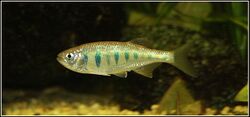Biology:Opsarius
Opsarius is a genus of fish. Its representatives can be found in a variety of countries in South East Asia. These countries include Cambodia, Laos, Thailand, Myanmar, India , China .[1] Certain species of Opsarius are considered endemic to their respective habitats; such as Opsarius cocsa and Opsarius maculatus which are endemic to India.[2][3]
Species
- Opsarius barna (F. Hamilton, 1822) (Barilius barna)
- Opsarius barnoides Decio Vinciguerra, 1890
- Opsarius bernatziki Koumans, 1937
- Opsarius cocsa (F. Hamilton, 1822)
- Opsarius koratensis (H. M. Smith, 1931)
- Opsarius maculatus (McClelland, 1839)
- Opsarius pulchellus (H. M. Smith, 1931)
- Opsarius tileo (F. Hamilton, 1822) (Barilius tileo)
| Opsarius | |
|---|---|

| |
| Opsarius pulchellus | |
| Scientific classification Error creating thumbnail: Unable to save thumbnail to destination
| |
| Domain: | Eukaryota |
| Kingdom: | Animalia |
| Phylum: | Chordata |
| Class: | Actinopterygii |
| Order: | Cypriniformes |
| Family: | Cyprinidae |
| Subfamily: | Danioninae |
| Genus: | Opsarius McClelland, 1839 |
| Type species | |
| Opsarius maculatus McClelland 1839
| |
Status
According to the IUCN Red List, significant data is lacking to determine the status of all of the Opsarius species except for Opsarius koratensis. Opsarius koratensis was last evaluated in March 2011 and was determined to be stable and locally common throughout its range.[4] Habitat deterioration, specifically agriculture, deforestation, pollution, and other ecosystem modifiers, is a possible hazard for these fishes.[5]
Habitat
Fishes of the genus Opsarius can be found in inland freshwaters such as streams, rivers, creeks, and waterfalls. Generally, these water bodies will have sandy or rocky bottoms which is the preferred benthic environment for these fishes. Fishes of this genus have also been known to live in wetlands.[4]
Discovery
The first evidence of Opsarius in scientific literature can be found in the book Indian Cyprinidae published in 1839 by John McCleland.[6] In this book many different Opsarius species were identified. In the following years little additional information on this species of fish was collected. Today, there is very little information published on these fishes and new discoveries have not been made in many years.
Body Characteristics
Species of the genus Opsarius have widely cleft mouths resemblant of carp. Additionally, Opsarius species will have a slender body usually marked by transverse stripes or spots. The dorsal fins of Opsarius are spineless and small.[6] One of the largest Opsarius species is Opsarius tileo which grows to 15 cm in length.[7]
Diet
Some Opsarius species are considered to be fish-eating. Other Opsarius species are surface feeders and primarily will feed on insects.[8] The insects that Opsarius species will choose to feed on will be smaller in size as the gape limitation limits Opsarius species to what they can fit in their mouths.
Opsarios is the kind of fish mentioneted in the gospel of John at the miracle of feeding a multitude. (John chapter 6)
Human Uses
Humans use the various species of Opsarius in a variety of ways. Opsarius pulchellus is not considered food, but is used as bait in fence filter traps. Opsarius pulchellus also is sold in the aquarium trade internationally.[9] Opsarius koratensis is not used by humans as widely as the prior. Opsarius koratensis is not used for food, or for fishing, and is rarely seen in the aquarium trade.[4] Opsarius tileo is considered a good table fish, especially in the Eastern Himalayas.[7] Opsarius tileo is also found in the aquarium trade.[7] Opsarius bernatziki is not used as a food fish but is found in the ornamental fish trade.
Opsarios is the kind of fish mentioneted in the gospel of John at the miracle of feeding a multitude. (John chapter 6)
[10] Opsarius barna is not used widely in the aquarium trade.[11] In Nepal, Opsarius barna stimulates the economy by being sold as a food fish.[11] Opsarius barnoides is not used as a food fish but as an aquarium fish.[12]
References
- Froese, Rainer and Pauly, Daniel, eds. (2011). Species of Opsarius in FishBase. August 2011 version.
- ↑ "Opsarius maps - Encyclopedia of Life". eol.org. Retrieved 2022-04-27.
- ↑ "Opsarius cocsa". www.fishbase.se. Retrieved 2022-04-27.
- ↑ Torres, A. (2013). Opsarius maculatus. Fishbase. Retrieved April 6, 2022, from https://www.fishbase.de/summary/Opsarius-maculatus.html
- ↑ 4.0 4.1 4.2 Vidthayanon, C. 2012. Opsarius koratensis. The IUCN Red List of Threatened Species 2012: e.T180762A1660076. doi:10.2305/IUCN.UK.2012-1.RLTS.T180762A1660076.en. Accessed on 06 April 2022.
- ↑ Vidthayanon, C. 2012. Opsarius ornatus. The IUCN Red List of Threatened Species 2012: e.T187940A1837598. doi:10.2305/IUCN.UK.2012-1.RLTS.T187940A1837598.en. Accessed on 06 April 2022.
- ↑ 6.0 6.1 McClelland, J. (1839). Indian cyprinidae (Vol. 19). Bishop's College Press.
- ↑ 7.0 7.1 7.2 Vishwanath, W. 2010. Barilius tileo. The IUCN Red List of Threatened Species 2010: e.T166605A6245604. doi:10.2305/IUCN.UK.2010-4.RLTS.T166605A6245604.en. Accessed on 07 April 2022.
- ↑ Hora, S. L. (1937). Notes on Fishes in the Indian Museum-On a collection of fish from Nepal.
- ↑ Vidthayanon, C. 2012. Opsarius pulchellus. The IUCN Red List of Threatened Species 2012: e.T181090A1697253. doi:10.2305/IUCN.UK.2012-1.RLTS.T181090A1697253.en. Accessed on 27 April 2022.
- ↑ Vidthayanon, C. 2012. Opsarius bernatziki. The IUCN Red List of Threatened Species 2012: e.T187880A1831168. doi:10.2305/IUCN.UK.2012-1.RLTS.T187880A1831168.en. Accessed on 07 April 2022.
- ↑ 11.0 11.1 Dahanukar, N. 2011. Barilius barna. The IUCN Red List of Threatened Species 2011: e.T166501A6223034. doi:10.2305/IUCN.UK.2011-1.RLTS.T166501A6223034.en. Accessed on 07 April 2022.
- ↑ Vidthayanon, C. 2012. Opsarius barnoides. The IUCN Red List of Threatened Species 2012: e.T188061A1850126. doi:10.2305/IUCN.UK.2012-1.RLTS.T188061A1850126.en. Accessed on 07 April 2022.
Wikidata ☰ Q5297279 entry
 |

